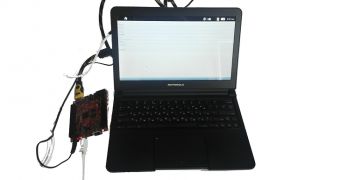If you’re a DIY (Do-It-Yourself) fan and you fancy the idea of having Tizen OS running on a laptop, keep on reading.
Samsung’s own open-source mobile operating system, Tizen has been gaining notoriety ever since the company launched its newest smartwatch products, the Gear 2 and Gear 2 Neo, at MWC 2014, back in February.
On top of that, Samsung hopes to launch the first Tizen-based smartphone soon, although the tech giant has encountered a few delays along the way. And the most recent information seems to indicate Sammy’s first Tizen OS smartphone is headed for markets like Russia and India.
Anyway, what about Tizen running on other type of devices, you might wonder. Well, Samsung had the Systena tablet, which runs the operating system, on display at MWC this year. The slate has already launched into the real world, but it was aimed at developers.
The tablet came with a 10.1-inch display with HD resolution (1920 x 1080 pixels) and draws power from an Exynos 4412 quad-core processor (like the one you’d find in the Galaxy Note 2 or Galaxy Note 10.1) combined with 2GB of RAM and 32GB of internal storage.
However, as it was reported back then, the tablet presented itself with some lagging in terms of performance, so it appeared that some work was still needed in optimization terms.
Moving away from tablets, you might be surprised to know a laptop running the same operating system is in existence.
The device is an open source project fathered by the Tizen-SunXi community (via Tizen Experts), which is a group committed to porting Tizen to devices running on Allwinner processors.
So this DIY community has posted a simple guide for assembling a portable notebook solution, similar to the Motorola LapDock with Raspberry combo that surfaced a few years ago.
Therefore, if you’re in the Do It Yourself movement and you’re handy with technology, all you need to do is gather the “ingredients” we’re going to be mentioning in next few lines.
All the gadgetry should be costing you approximately $200 / €147, and you can acquire most of the needed components online.
We’ll commence by telling you that you’ll need a single board computer (in the walk-through video below, an A10S-OlinuXino-MICRO board is used).
This tutorial also uses the Motorola LapDock which can be found on eBay for a meager $100 / €73. Furthermore, you’ll need an HDMI cable, HDMI Female to micro HDMI Male adapter, Micro HDMI Female to Female Adapter, USB 2.0 A Female to Micro USB B 5 Pin Male OTG Adapter Plug, USB Male to Male cable Which 5 volt red wire.
As you can see, the laptop in the video appears to be running smoothly. If you’re interested in hearing more about this project, you should know the author of the video will be holding a speech at the Tizen Developer Conference 2014, which is scheduled to start on June 2.

 14 DAY TRIAL //
14 DAY TRIAL // 